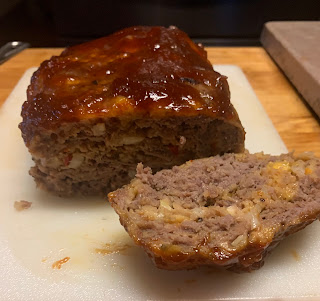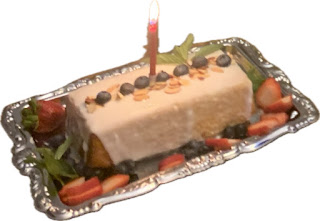Ritz (butter) crackers, along with ground beef form the basis for this tasty meatloaf. While we love meatloaf as an entrée, we certainly look forward to tomorrow’s meatloaf sandwiches!
MAKE AHEAD INSTRUCTIONS — The other thing I really like about meatloaf . . . is that it can be made ahead. I assembled the sauce and meatloaf (steps 2-4) and placed them in the refrigerator. When ready to bake, I pulled them out and followed steps 5-7.
Ritzy (Cracker) Meatloaf 6+ servings
Meatloaf Glaze
1/2 cup ketchup
1/4 to 1/3 cup brown sugar
1 tablespoon yellow mustard
1 teaspoon Worcestershire sauce
Meatloaf
1 lb. ground beef (lean 85%)
1/2 cup yellow onion, finely diced
1/4 cup red, yellow, orange or green peppers, finely dice
2 eggs
4 oz. (1 cup) sharp Cheddar cheese
1/4 cup whole milk
32 (1 sleeve) Ritz crackers (or any brand of butter cracke), finely crushed
1 teaspoon each: salt, pepper & Italian seasoning
1/2 teaspoon garlic powder
- Preheat oven to 350°F. (Do this later if following the make ahead instructions explained above.)
- In a small bowl combine the glaze ingredients, whisk untils mooth. Set aside for later.
- In a large mixing bowl add the ground beef, onion, green pepper, eggs, cheese, milk, crushed Ritz crackers, salt, and pepper. Using clean hands, thoroughly combine all ingredients but avoid overmixing.
- Place meatloaf mixture onto a baking pan lined with parchment paper (that has been spritzed with non-stick spray) and form it into a loaf shape.
- Bake at 350°F for 30 minutes, remove from the oven and apply the glaze over the top of the meatloaf.
- Return meatloaf to the oven and continue baking for 30 minutes or until the meatloaf is 160°F when the temperature is checked in the center of the loaf.
- Remove from oven and allow to rest for 10 minutes.
Recipe without photos . . . Ritzy (Cracker) Meatloaf 6+ servings
Meatloaf Glaze
1/2 cup ketchup
1/4 to 1/3 cup brown sugar
1 tablespoon yellow mustard
1 teaspoon Worcestershire sauce
Meatloaf
1 lb. ground beef (lean 85%)
1/2 cup yellow onion, finely diced
1/4 cup red, yellow, orange or green peppers, finely dice
2 eggs
4 oz. (1 cup) sharp Cheddar cheese
1/4 cup whole milk
32 (1 sleeve) Ritz crackers (or any brand of butter cracke), finely crushed
1 teaspoon each: salt, pepper & Italian seasoning
1/2 teaspoon garlic powder
- Preheat oven to 350°F. (Do this later if following the make ahead instructions explained above.)
- In a small bowl combine the glaze ingredients, whisk untils mooth. Set aside for later.
- In a large mixing bowl add the ground beef, onion, green pepper, eggs, cheese, milk, crushed Ritz crackers, salt, and pepper. Using clean hands, thoroughly combine all ingredients but avoid overmixing.
- Place meatloaf mixture onto a baking pan lined with parchment paper (that has been spritzed with non-stick spray) and form it into a loaf shape.
- Bake at 350°F for 30 minutes, remove from the oven and apply the glaze over the top of the meatloaf.
- Return meatloaf to the oven and continue baking for 30 minutes or until the meatloaf is 160°F when the temperature is checked in the center of the loaf.
- Remove from oven and allow to rest for 10 minutes.




















